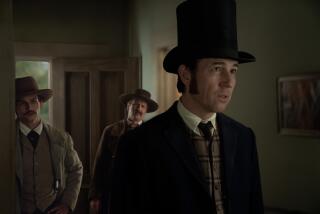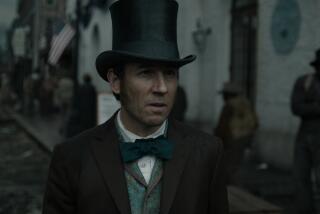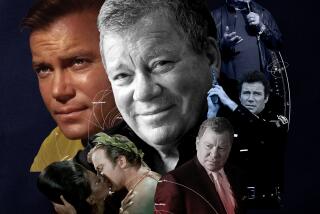As Davy, he makes a stand
The battle for the Alamo lasted only 90 minutes. The struggle to bring Touchstone Pictures’ movie about the 1836 Texas massacre took considerably longer. Two years ago, Ron Howard and Russell Crowe were preparing their big-screen version of the siege, previously chronicled in John Wayne’s 1960 action epic.
When Howard’s $125-million budget proved too rich for the studio’s blood, Texas-born filmmaker John Lee Hancock took over, re-envisioning the story with Texas native Dennis Quaid as Sam Houston and Jason Patric playing knife-meister Jim Bowie. For the Alamo’s most famous defender, Hancock stuck with Howard’s original choice: Billy Bob Thornton is Davy Crockett.
In “The Alamo,” Crockett comes across as a folksy celebrity grappling with the demands of his public image. In that regard Thornton is well versed. Since his 1996 breakthrough in “Sling Blade,” the soft-spoken Arkansas actor has cultivated his own eccentric persona, famously amplified by his dramatic relationship with Angelina Jolie. But “The Alamo” also marks a departure for Thornton, who rarely appears in big-budget spectacles and has never before portrayed a real-life historic figure.
Were you always a Davy Crockett fan?
As a kid I watched Fess Parker’s TV show and saw the John Wayne movie, and I was always Davy Crockett when we played Alamo in the backyard. Always. I had two brothers, but I was the oldest and the biggest, so I got to choose. Davy Crockett was like Paul Bunyan or somebody -- more a cartoon character than a real person.
The Alamo obviously means a lot to Texans, but you grew up in Arkansas. Did the Alamo loom large in your imagination?
Arkansas has always kind of been considered the snot-nosed little brother of Texas. A lot of my relatives lived in Texas and I lived in Houston for a while, so I’m kind of a semi-Texan. But yeah, in Arkansas, the Alamo is legendary. The thing is, we only knew the storybook version. Later on you realize the history books didn’t exactly give you the whole story. I mean, Jim Bowie was a slave trader. We didn’t learn that in school.
Gen. Santa Anna, the Mexican dictator, is portrayed as this brutal villain, but Texas did belong to Mexico during the 1830s, right?
The whole thing is a little ambiguous. We were taught that the Alamo was about men fighting for independence or to protect their land. In fact they were fighting to get it away from somebody else. On the other hand, Santa Anna really was a cruel man. Like most of those people at the Alamo, Davy Crockett came to Texas because it wasn’t settled yet and he was looking for a new start.
There were 189 men inside the Alamo surrounded by about 2,500 Mexican soldiers. Why didn’t Crockett and the others try to escape?
There was something about men, particularly in those days, where nobody wanted to be the guy who chickened out. Nobody was going to leave the guy next to him behind, so instead they had to stand and fight. That’s one reason I think people consider the men at the Alamo to be heroes: It’s in our nature to root for the underdog. When you have a very few against the very many, that’s a story people always respond to.
We think of Crockett as this great frontiersman, but in the movie we also learn he played fiddle and liked to be called “David.” What did you discover about Crockett while preparing for this role?
One thing that really surprised me is that Crockett only had six months’ education. I also didn’t really know about him as this congressman who went to Washington. In those days, you could come out of the woods and stand in the center of town on a soapbox and tell people what you were going to do for them, and they would vote for you just because you were some guy they liked.
Davy Crockett, a politician?
I actually liken Davy Crockett to Bill Clinton in a lot of ways. I’ve known Bill forever, because he was friends with my mom, and one of the things about Clinton is that he really wants people to like him. Everything I read about Crockett indicates he was the same way. Crockett was this friendly, humorous Mark Twain/Will Rogers-type guy who came out of nowhere to became a celebrity, and then he had to live up to it.
That brings us to your death scene, where Crockett is about to be executed. What was going through your mind when you did the scene?
Crockett sees this Mexican soldier wearing his coonskin cap and realizes the absurdity of the moment. He’s perpetuated this legend, plays have been written about him, but what do the stories mean right now, that I killed a bear when I was 3 or wrestled a mountain lion or whatever. Crockett’s thinking, “I’d like to go back and see my kids. I’m as mortal as anyone else and at the end of the day, this legend stuff doesn’t mean anything.”
-- Hugh Hart
More to Read
Only good movies
Get the Indie Focus newsletter, Mark Olsen's weekly guide to the world of cinema.
You may occasionally receive promotional content from the Los Angeles Times.









